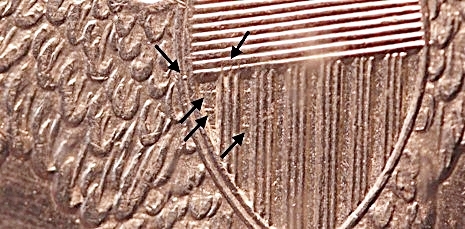|
|
Comments: This is the only use of Obverse 7 and second of four uses of Reverse A in 1842. Reverse A is transitional, later used to strike die marriage OC-1 in 1843. |
Obverse 7 The photo below shows the Obverse 7 attribution grid.  1842 Obverse 7 attribution grid Minor Obverse 7 die markers that may be useful for attribution are some light die polish lines that extend from Miss Libertyís arm into the field just left of the pole. These are shown in the following photo.  1842 Obverse 7 die polish lines Obverse 7 is very similar to Obverse 1, so much so the I mis-attributed two OC-8 examples as OC-1 in my research for the first edition. The marks above the elbow are similar. The date exhibits minor position differences. Be very careful when attempting to differentiate the two die marriages. OC-1 is much more common.
|
Reverse A Reverse A displays several noted die lines in the upper left shield recesses. These are pictured in the photo below.  1842 Reverse A die lines in shield recesses
OC-8 is a new die marriage, identified after the publication of my first edition. Itís currently the only new die marriage identified since that January, 2018 publication. I discovered it while updating my auction archives research in preparation for the publication of this second edition. |
| Photo credits:
Obverse 7: 1842 NGC MS61 from the Heritage archives. Reverse A: 1842 PCGS MS62 CAC, from the Osburn-Cushing reference collection. |
